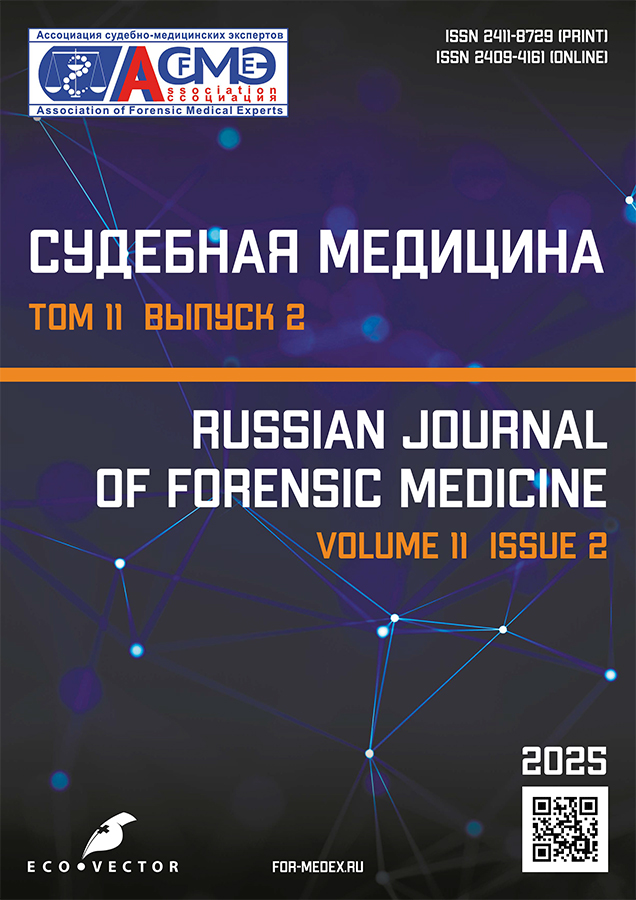Postmortem soft tissue damage caused by mice: a case report
- Authors: Lavrukova O.S.1, Kobzev A.M.2
-
Affiliations:
- Petrozavodsk State University
- Bureau of Forensic Medical Examination
- Issue: Vol 11, No 2 (2025)
- Pages: 196-203
- Section: Case reports
- Submitted: 17.04.2025
- Accepted: 18.07.2025
- Published: 27.08.2025
- URL: https://for-medex.ru/jour/article/view/16289
- DOI: https://doi.org/10.17816/fm16289
- EDN: https://elibrary.ru/DKNUTK
- ID: 16289
Cite item
Abstract
Postmortem injuries inflicted by small rodents such as house and field mice are a significant aspect of forensic medical examination. However, systematic data on this subject remains scarce. Available publications primarily focus on injuries caused by rats, whereas those inflicted by mice receive less attention. This article presents a case illustrating the specific features of soft tissue damage resulting from mouse activity.
A man’s body was discovered in a wooden house in a village, bearing a neck injury. A forensic examination revealed a soft tissue defect on the right lateral surface of the neck, along with signs of its postmortem origin from small rodent teeth (house and field mice). Establishing the postmortem origin of the soft tissue defect caused by small rodent teeth, as well as an intact external jugular vein at the base of the defect, helped to rule out the possibility that the injury was inflicted by a sharp object.
Mice have a less developed masticatory apparatus than rats; as a result, the damage they inflict mostly affects soft tissues. They prefer to gnaw on stiffened tissues (e.g., during the winter months when tissues become more rigid), and this damage has distinct morphological characteristics. Moreover, mouse activity can significantly alter the appearance of antemortem injuries. The presence of animal tissues, hairs, and feces within the damaged area provides additional evidence of rodent activity and necessitates further analysis.
Keywords
Full Text
About the authors
Olga S. Lavrukova
Petrozavodsk State University
Author for correspondence.
Email: olgalavrukova@yandex.ru
ORCID iD: 0000-0003-0620-9406
SPIN-code: 6395-8638
MD, Dr. Sci. (Medicine), Assistant Professor
Russian Federation, PetrozavodskAlexey M. Kobzev
Bureau of Forensic Medical Examination
Email: sudmed2007@inbox.ru
ORCID iD: 0000-0002-7600-9808
SPIN-code: 6746-6445
MD
Russian Federation, PetrozavodskReferences
- Klingelhöffer D. Zweifelhafte Leichenbefunde durch Benagung von Insekten. Vierteljahrsschr Gerichtl Med Öffentl Sanitätswesen. 1898;15:58–63. (In German)
- Vlasyuk IV, Leonov SV. Materials for Forensic Medical Assessment of Damage Caused by Some Animals. Khabarovsk: Far Eastern State Medical University; 2011. (In Russ.) ISBN: 978-5-98247-036-2 EDN: ZTRTPJ
- Vlasiuk IV, Leonov SV. Classification of Skin Injuries Inflicted by the Teeth of the Carnivores. Forensic Medical Expertise. 2012;55(2):28–31. EDN: PEKDWF
- Vlasyuk IV, Tumanov EV. Characteristics of Skin and Bone Injuries in the Cadaver Inflicted by Rat Teeth. Forensic Medical Expertise. 2010;53(4):19–20. EDN: PWXQYJ
- Vlasyuk IV. Morphological Characteristics of Soft Tissue Defect Caused by Rats. Meditsinskaya ekspertiza i pravo. 2010;(6):37–41. EDN: NDDFCD
- Potapova EG. Morpho-Functional Transformations of the Jaw Muscles in the Evolution of Rodents. Journal of General Biology. 2019;80(4):260–273. doi: 10.1134/S0044459619040079 EDN: LNUQBH
- Tsokos M, Schulz F. Indoor Postmortem Animal Interference by Carnivores and Rodents: Report of Two Cases and Review of the Literature. International Journal of Legal Medicine. 1999;112(2):115–119. doi: 10.1007/s004140050212 EDN: AWDVFN
- Weeratna JB, Amararathna S, Ranasinghe RASK, Vidanapathirana M. Indoor Postmortem Animal Scavenging - A Case Report. Sri Lanka Journal of Forensic Medicine, Science & Law. 2014;5(1):2–8. doi: 10.4038/sljfmsl.v5i1.7743
- Tsokos M, Matschke J, Gehl A, et al. Skin and Soft Tissue Artifacts Due to Postmortem Damage Caused by Rodents. Forensic Science International. 1999;104(1):47–57. doi: 10.1016/S0379-0738(99)00098-5
- Koszyca B, Gilbert JD, Byard RW. Antemortem Trauma From Rodent Activity: The Popiel Phenomenon. Forensic Science, Medicine and Pathology. 2006;2(4):269–272. doi: 10.1385/FSMP:2:4:269
- Gapert R, Tsokos M. Anthropological Analysis of Extensive Rodent Gnaw Marks on a Human Skull Using Post-Mortem Multislice Computed Tomography (pmMSCT). Forensic Science, Medicine, and Pathology. 2012;9(3):441–445. doi: 10.1007/s12024-012-9363-9
Supplementary files












